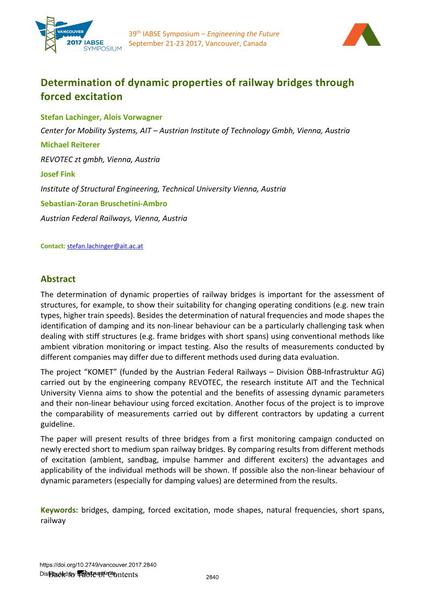Determination of dynamic properties of railway bridges through forced excitation

|
|
|||||||||||
Bibliographic Details
| Author(s): |
Stefan Lachinger
(Center for Mobility Systems, AIT – Austrian Institute of Technology Gmbh, Vienna, Austria)
Alois Vorwagner (Center for Mobility Systems, AIT – Austrian Institute of Technology Gmbh, Vienna, Austria) Michael Reiterer (REVOTEC zt gmbh, Vienna, Austria) Josef Fink (Institute of Structural Engineering, Technical University Vienna, Austria) Sebastian-Zoran Bruschetini-Ambro (Austrian Federal Railways, Vienna, Austria) |
||||
|---|---|---|---|---|---|
| Medium: | conference paper | ||||
| Language(s): | English | ||||
| Conference: | IABSE Symposium: Engineering the Future, Vancouver, Canada, 21-23 September 2017 | ||||
| Published in: | IABSE Symposium Vancouver 2017 | ||||
|
|||||
| Page(s): | 2840-2847 | ||||
| Total no. of pages: | 8 | ||||
| Year: | 2017 | ||||
| DOI: | 10.2749/vancouver.2017.2840 | ||||
| Abstract: |
The determination of dynamic properties of railway bridges is important for the assessment of structures, for example, to show their suitability for changing operating conditions (e.g. new train types, higher train speeds). Besides the determination of natural frequencies and mode shapes the identification of damping and its non-linear behaviour can be a particularly challenging task when dealing with stiff structures (e.g. frame bridges with short spans) using conventional methods like ambient vibration monitoring or impact testing. Also the results of measurements conducted by different companies may differ due to different methods used during data evaluation. The project “KOMET” (funded by the Austrian Federal Railways – Division ÖBB-Infrastruktur AG) carried out by the engineering company REVOTEC, the research institute AIT and the Technical University Vienna aims to show the potential and the benefits of assessing dynamic parameters and their non-linear behaviour using forced excitation. Another focus of the project is to improve the comparability of measurements carried out by different contractors by updating a current guideline. The paper will present results of three bridges from a first monitoring campaign conducted on newly erected short to medium span railway bridges. By comparing results from different methods of excitation (ambient, sandbag, impulse hammer and different exciters) the advantages and applicability of the individual methods will be shown. If possible also the non-linear behaviour of dynamic parameters (especially for damping values) are determined from the results. |
||||
| Keywords: |
bridges natural frequencies railroad damping short spans forced excitation mode shapes
|
||||
